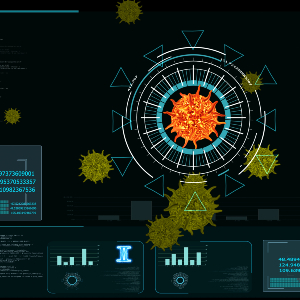
For the past two years, COVID-19 has had a significant effect on our lives. and it has also dramatically affected the world. Its spread has forced healthcare providers to step up their efforts and do things that seemed impossible before.
During the crisis, governments and private organizations were forced to invest resources into the research and development of AI. Even before the virus emerged, Artificial Intelligence (AI) has been used in medicine for many years. Still, the pandemic led to its faster adoption and practical implementation. AI data analysis algorithms were utilized to diagnose the novel coronavirus in its early stages to moderate success. In this article, we will discuss the positive effects of AI technology on COVID-19 treatment.
Tracking the Spread
Throughout the pandemic, tech products have been extremely helpful in stopping the spread of the disease. AI was utilized for real-time tracking of the virus and making data-based predictions.
Today, there is no shortage of user data, especially in cities. Thanks to IoT and wearable technologies, there is a wealth of information available about their users. The problem is that humans are incapable of analyzing vast amounts of data on their own. That’s where AI companies come in. Their solutions can classify and pinpoint the most important information in the data sets.
AI can predict potential areas of viral growth, which allows governments to take precautionary measures. It can also track the efficiency of the enforced regulations. Private and public organizations also use this technology to visually present the data and make it more accessible for analysis.
Diagnostics
The COVID-19 pandemic has affected populations all around the world. AI has contributed to alleviating some of the most difficult diagnostic tasks.
Providing an early diagnosis for COVID-19 patients has been one of those. Since the start of the pandemic, detecting the signs of the virus at early stages has been the key to saving lives. The earliest AI solutions were utilized to automatically analyze CT scans to differentiate between pneumonia and COVID-19.
The results of big data analysis wee also useful in the early research process. Patterns that emerged gave doctors a solid foundation to study the virus and its development in individual patients.
Early detection of the virus has saved many lives by providing appropriate treatment as well as helping to prevent outbreaks. The importance of interconnected devices in accurately tracking the spread of the virus cannot be stressed enough.
Improving Hospital Efficiency
Diagnosing the virus is extremely important, but saving doctors’ and nurses’ time can save many lives as well. The technology allows doctors to treat patients efficiently and much quicker. By automating the most mundane parts of the treatment, AI can improve the efficiency of medical operations. Doctors can easily categorize their patients depending on their condition and come up with the most effective treatment.
AI companies working on telemedicine solutions can also relieve some pressure put on hospitals. Thanks to the efforts of AI companies, individuals who live in rural areas can get fast and credible medical advice. When the hospitals are overcrowded, preventing unnecessary visits can save many lives. Through AI-powered chatbots, patients can get highly informative answers automatically, which can be useful for patient education and triaging.
The scope of AI solutions is no longer limited to data analysis and improving efficiency. AI-powered robots can perform manual labor like cleaning and disinfecting wards.
Stopping Misinformation
The primary focus of AI is to analyze massive amounts of data and detect patterns. Governments also use AI to stop online misinformation, especially those pertaining to vaccination which is frequently disseminated on social networks. AI solutions can come in handy in this regard, too. Social networks are doing their part by using AI to stop the spreading of false information. Machine learning systems can be trained to identify inaccuracies and warn the users.
Data Quality
Using AI to stop the spread of COVID- 19 does not come without its challenges. The biggest challenge is the poor quality of publicly available data. Because of inconsistencies, the spread of the virus can also be hard to analyze.
Many errors in AI diagnosis can be attributed to the poor quality of data used to train the algorithms. In the early stages of the pandemic, medical professionals did not have time to properly document every case and organize the data. In addition, publicly available bits of data were either mislabeled or unreliable. As a result, the AI algorithms that trained on the incomplete, mislabeled, unreliable data sometimes made mistakes.
The quality of data has since improved, mainly because of the fact that healthcare workers gained more experience in treating the virus. Still, during the crisis, it’s nearly impossible to collect well-documented data. At the moment, the datasets are too diverse and disorganized, so analyzing them is a big challenge.
Furthermore, instead of working together, many AI companies initially rushed to develop their own diagnostic AI solutions. As a result, we had many solutions that left much to be desired. To solve these problems, AI pioneers needed to collaborate more and come up with solutions together. Fortunately, the trend seems to be moving towards information sharing.
Conclusion
AI-powered tools can be extremely effective against COVID-19. The technology can help us track the spread of disease, provide early diagnosis, and also importantly, stop misinformation.
